It probably isn’t news to you that vegetables are an essential part of a healthy diet. But when greens like kale gain enormous attention for being the “it” superfood — and are now regularly consumed in what were once unthinkable ways, such as in smoothies or as chips — it’s easy to wonder if your everyday romaine isn’t quite cutting it.
Guess what? Outside the spotlight on certain superstar superfoods, there are many varieties of lettuce and other greens that also have a lot to offer in the nutrition department.

A general rule of thumb is that the darker the green, the better it is for you. That doesn’t mean you should write off lighter varieties as part of your diet, though. Although mostly water, just one cup of soft-textured, lighter greens such as bibb, green leaf, or butterhead lettuce still provides up to 50 percent of your daily vitamin A needs and 70 percent of vitamin K requirements — all for less than 10 calories. Romaine lettuce, although often underrated, not only gives your (lightly dressed) Caesar or Greek-style salad that satisfying crunch, but also delivers substantial vitamin C, vitamin A, and potassium. Mixed greens such as mesclun vary, depending on what types of lettuces are incorporated; however, you can count on them boasting similar nutrients. Greens grown hydroponically (in a nutrient solution) are believed to offer similar nutritional value as those grown in soil — and may be a good, fresh option during those winter months when getting more traditionally grown local greens is not possible.
Venturing beyond lettuces to other potential salad greens opens up even more nutrient-dense options for the table. Just like eating a variety of colorful vegetables is the best way to get the most nutrients in your diet, changing up your go-to green is a good way take advantage of the range of vitamins, nutrients, and incredibly unique flavors that each has to offer.
As the spectrum of greens gets, well greener, the nutrition values become more robust. Here are just a few (of the many) other high performers that can give kale a run for its money in the nutrition department.
Watercress: According to a 2014 report released by the CDC, watercress ranked the highest in nutrient density out of 41 other vegetables (13 levels higher than kale!). A small-yet-mighty ingredient, watercress is the perfect addition to nearly any dish — salad, pasta, sauce, soup, or even a green smoothie.
Dandelion Greens: These nutritious “weeds” (we prefer “wild greens”) are showing up in more mainstream grocery stores (look at your local health-food store or farmers’ market if you can’t find them). They are delicious sautéed with other whole grains and other vegetables, added to soups, made into a fresh pesto, or on top of bean burger.

Turnip and Beet Greens: Whether sold separately or still attached to their root vegetable cousins, these underappreciated greens are good sources of fiber and a variety of vitamins, minerals, and phytonutrients. Sharply flavored with a spiciness similar to that of a radish, they are better cooked than raw — simply remove the biggest stems, sautée the greens with garlic, olive oil, and a pinch of salt and/or other spices to tame their bitter flavor, then eat solo or add to soups, make into pesto, or make a beet-green risotto. (When using beet greens, don’t be alarmed if your dish ends up with a pinkish-red hue!)
Collard Greens: These nutritional powerhouses long beloved in Southern-style cooking are an excellent source of a variety of vitamins and minerals, most notably vitamins A, C, K, and folate, as well as calcium, iron, and magnesium. When cooked to soften their texture and bitterness, they are incredibly versatile and can be used in soups, stews, or even as a wrap alternative (if first lightly steamed).
All greens quickly begin losing nutritional value (and flavor) the longer they sit in your refrigerator (or on a truck traveling across the country to your grocery store shelves), so buy local when you can, and eat (or cook!) within a few days of purchase. And remember, if kale isn’t your jam — or even if it is — no one vegetable is going to solve all health problems, so give other greens and vegetables some love occasionally.
At Bon Appétit, we know there’s a lot on your plate that you worry about. That’s why we have a team of registered dietitian nutritionists ready to answer your nutrition questions about which food choices will help you avoid unwanted pounds, work or study (and sleep!) better, and form long-lasting healthy eating habits. Email your questions and feedback to nutrition@cafebonappetit.com.